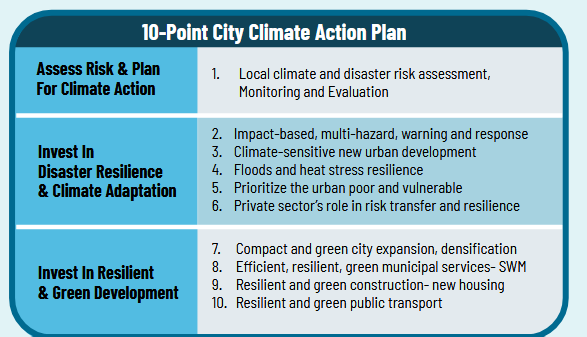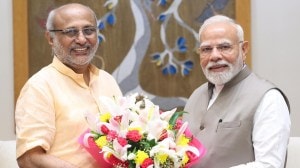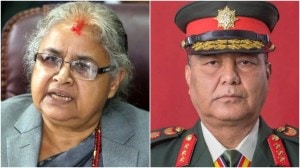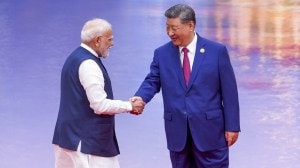
Why in the news?
Recently, the World Bank, in collaboration with the Union Ministry of Housing and Urban Affairs, has released a report titled Towards Resilient and Prosperous Cities in India. The Report estimated that Indian cities will require $2.4 trillion by 2050 to build climate-resilient infrastructure and services.
Story continues below this ad
Key Takeaways:
1. The report projects that the country’s urban population will nearly double to 951 million by 2050, and that by 2030, cities will account for 70 per cent of all new employment generated. In addition to the rapid pace of urbanisation, Indian cities will face two major shocks in a business-as-usual scenario — flooding and extreme heat.
2. The report said that climate change and urbanization patterns are the main drivers of stormwater-related or pluvial flooding risks, with a forecasted increase in risk of 3.6 to 7 times by 2070. Annual estimated losses just from pluvial or storm water related flooding are likely to increase from $4 billion in 2023 to up to $14-30 billion by 2070, exposing up to 46.4 million people.
3. Heat-related deaths can double to over 3 lakh each year by 2050 due to global warming and the urban heat island phenomenon, the report said. Measures like shifting working hours to early morning and late afternoon, urban greening, early warning systems, and cool roofs can save over 1.3 lakh lives, it added.
4. Urban Heat Island effect compounds the impact of increasingly frequent and severe heat waves. If nothing changes, it is projected that heat-related deaths in Indian cities will double by 2050.
Story continues below this ad
| What is the urban heat island effect? |
| An urban heat island is a local and temporary phenomenon experienced when certain pockets within a city experience a higher heat load than surrounding or neighbouring areas on the same day. The variations are mainly due to heat remaining trapped within locations that often resemble concrete jungles. The temperature variation can range between 3 to 5 degrees Celsius. |
5. The report makes several recommendations for national- and state-level interventions, including boosting private sector engagement, creating a financing roadmap, and setting standards to build municipal capacities. For cities, it calls for risk evaluation and the mobilisation of capital — including private investment — to support mitigation and adaptation efforts.
 The report provided 10 recommendations to be taken by Indian cities to plan and invest in climate solutions. (Source: World Bank report)
The report provided 10 recommendations to be taken by Indian cities to plan and invest in climate solutions. (Source: World Bank report)
Types of Urban flooding:
According to the World Bank, urban flooding is classified into three categories:
(a) Pluvial flooding: It occurs when heavy rainfall overwhelms the absorbing capacity of the soil and drainage capacity, causing surface runoff to accumulate. “Urbanization increases impervious areas and leads to the construction of conduits and channels, increasing the peak flood flow”, said the World Bank report.
(b) Coastal flooding: “It is most frequently the result of storm surges and high winds coinciding with high tides. The surge itself is the result of the raising of sea levels due to low atmospheric pressure,” according to UNDRR.
Story continues below this ad
(c) Fluvial flooding: It occurs when intense or excessive precipitation or snow melt causes rivers to overflow. “It is a rise, usually brief, in the water level of a stream or water body to a peak from which the water level recedes at a slower rate,” according to WMO. The impact of flooding is realised when the floodplains are occupied by the population, exposing them to flooding.
In addition, flash floods are recurring events in urban spaces. It refers to such a situation, but occurring in a much shorter span of time (3-6 hours), and is highly localised. In India, flash floods are often associated with cloudbursts – sudden, intense rainfall in a short period of time. Himalayan states further face the challenge of overflowing glacial lakes, formed due to the melting of glaciers, and their numbers have been increasing in the last few years.
BEYOND THE NUGGET: Urban Local Bodies (ULBs)
“In order for cities to invest in resilience, adaptation, and mitigation, they need to have some kind of autonomy to make decisions and implement them. Some people think this can be achieved only by fully implementing the 74th Amendment; others disagree,” Auguste Tano Kouame, the World Bank’s Country Director for India, said at a media briefing.
1. The 74th Constitutional Amendment Act of 1992 gave constitutional status to Urban Local Bodies (ULBs) to strengthen local self-governance. However, official audits as recently as 2022 have found that several states have yet to fully implement its provisions.
Story continues below this ad
2. The first municipal body was established in Madras in 1687, followed by Bombay and Calcutta. In 1882, Lord Ripon (often called as father of local self-government in India) introduced the resolution for local-self governments, thereby laying the foundations of a democratically elected municipal government to manage cities.
3. Urban local bodies (ULBs), i.e., Municipal Corporations, Municipalities, or Nagar Panchayats, are the fundamental unit of urban governance in our cities. They are the first point of contact for citizens and are responsible for providing essential services such as waste management, sanitation, and urban planning.
4. Part IX-A of the Indian constitution details the composition, roles, and responsibilities of these ULBs and grants them powers to manage a range of services, from urban planning and land use to public health and waste management.
5. The 12th Schedule of the Constitution specifies 18 functions that are devolved to these ULBs. The amendment also mandated elections every five years, with municipal councillors elected from local constituencies (wards). While the elected mayor serves as the ceremonial head, real executive power rests with the municipal commissioner, a state-appointed bureaucrat.
Story continues below this ad
6. However, municipal bodies are stretched thin, managing everything from waste collection to city planning. ULBs have insufficient resources and limited personnel to address a wide variety of complex urban problems.
7. To address this, the Union Budget 2025-26 announced that the government will set up the Urban Challenge Fund of Rs 1 lakh crore to implement the proposals for ‘Cities as Growth Hubs’, ‘Creative Redevelopment of Cities’, and ‘Water and Sanitation.’
Post Read Questions
(1) The ‘Towards Resilient and Prosperous Cities in India’ report was published by the Union Ministry of Housing and Urban Affairs in collaboration with
(a) NITI Aayog
(b) World Bank
(c) WMO
(d) BIMSTEC Secretariat
(2) Which of the following is/are true regarding Urban Local Bodies in India? (UPSC CAPF 2014)
Story continues below this ad
1. The Constitution’s 74th Amendment Act envisages three types of urban local bodies, namely Nagar Panchayat, Municipal Council, and Municipal Corporation.
2. Municipal Corporations are established in cities with a population greater than 1 million.
3. Bombay and Calcutta Corporations were the first Municipal Corporations that were established during British time.
Select the correct answer using the code given below:
(a) 1 and 2 only
(b) 2 only
(c) 1 and 3 only
(d) 1, 2 and 3
UPSC Specials on ULBs: Significance of empowering local bodies for effective urban governance in India, How paid parking could change urban mobility and cut emissions, How Budget 2025 empowers India’s cities as engines of economic growth
Story continues below this ad
(Source: World Bank Report: By 2030, Indian cities to create 70% of jobs but may lose $5 bn to floods; need greater autonomy to counter climate risks, worldbank.org)
Subscribe to our UPSC newsletter. Stay updated with the latest UPSC articles by joining our Telegram channel – IndianExpress UPSC Hub, and follow us on Instagram and X.
🚨 Click Here to read the UPSC Essentials magazine for July 2025. Share your views and suggestions in the comment box or at manas.srivastava@indianexpress.com🚨

Click on this link to join


 The report provided 10 recommendations to be taken by Indian cities to plan and invest in climate solutions. (Source: World Bank report)
The report provided 10 recommendations to be taken by Indian cities to plan and invest in climate solutions. (Source: World Bank report)































